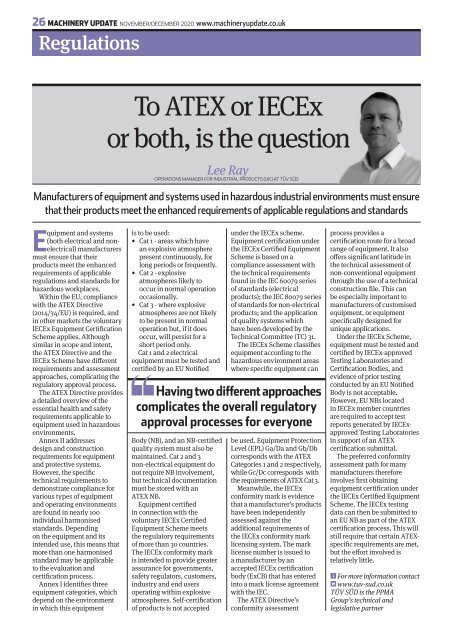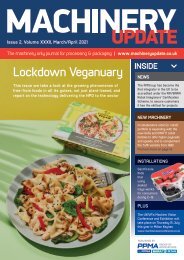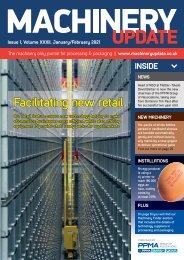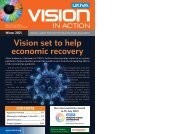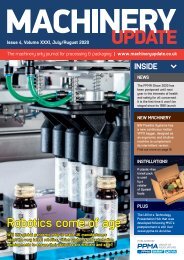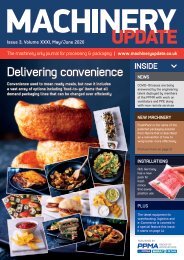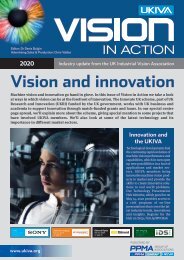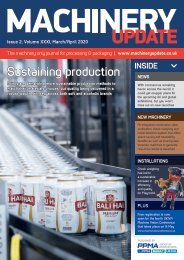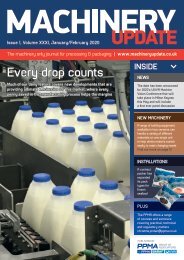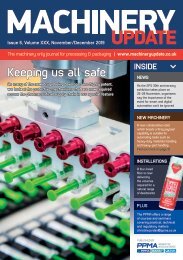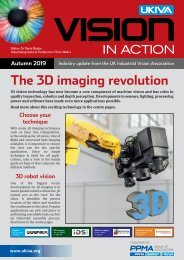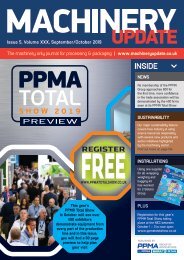Machinery Update | November / December 2020
Create successful ePaper yourself
Turn your PDF publications into a flip-book with our unique Google optimized e-Paper software.
26 MACHINERY UPDATE NOVEMBER/DECEMBER <strong>2020</strong> www.machineryupdate.co.uk<br />
Regulations<br />
To ATEX or IECEx<br />
or both, is the question<br />
Lee Ray<br />
OPERATIONS MANAGER FOR INDUSTRIAL PRODUCTS (UK) AT TÜV SÜD<br />
Manufacturers of equipment and systems used in hazardous industrial environments must ensure<br />
that their products meet the enhanced requirements of applicable regulations and standards<br />
Equipment and systems<br />
(both electrical and nonelectrical)<br />
manufacturers<br />
must ensure that their<br />
products meet the enhanced<br />
requirements of applicable<br />
regulations and standards for<br />
hazardous workplaces.<br />
Within the EU, compliance<br />
with the ATEX Directive<br />
(2014/34/EU) is required, and<br />
in other markets the voluntary<br />
IECEx Equipment Certification<br />
Scheme applies. Although<br />
similar in scope and intent,<br />
the ATEX Directive and the<br />
IECEx Scheme have different<br />
requirements and assessment<br />
approaches, complicating the<br />
regulatory approval process.<br />
The ATEX Directive provides<br />
a detailed overview of the<br />
essential health and safety<br />
requirements applicable to<br />
equipment used in hazardous<br />
environments.<br />
Annex II addresses<br />
design and construction<br />
requirements for equipment<br />
and protective systems.<br />
However, the specific<br />
technical requirements to<br />
demonstrate compliance for<br />
various types of equipment<br />
and operating environments<br />
are found in nearly 100<br />
individual harmonised<br />
standards. Depending<br />
on the equipment and its<br />
intended use, this means that<br />
more than one harmonised<br />
standard may be applicable<br />
to the evaluation and<br />
certification process.<br />
Annex I identifies three<br />
equipment categories, which<br />
depend on the environment<br />
in which this equipment<br />
is to be used:<br />
• Cat 1 - areas which have<br />
an explosive atmosphere<br />
present continuously, for<br />
long periods or frequently.<br />
• Cat 2 - explosive<br />
atmospheres likely to<br />
occur in normal operation<br />
occasionally.<br />
• Cat 3 - where explosive<br />
atmospheres are not likely<br />
to be present in normal<br />
operation but, if it does<br />
occur, will persist for a<br />
short period only.<br />
Cat 1 and 2 electrical<br />
equipment must be tested and<br />
certified by an EU Notified<br />
Body (NB), and an NB-certified<br />
quality system must also be<br />
maintained. Cat 2 and 3<br />
non-electrical equipment do<br />
not require NB involvement,<br />
but technical documentation<br />
must be stored with an<br />
ATEX NB.<br />
Equipment certified<br />
in connection with the<br />
voluntary IECEx Certified<br />
Equipment Scheme meets<br />
the regulatory requirements<br />
of more than 30 countries.<br />
The IECEx conformity mark<br />
is intended to provide greater<br />
assurance for governments,<br />
safety regulators, customers,<br />
industry and end users<br />
operating within explosive<br />
atmospheres. Self-certification<br />
of products is not accepted<br />
under the IECEx scheme.<br />
Equipment certification under<br />
the IECEx Certified Equipment<br />
Scheme is based on a<br />
compliance assessment with<br />
the technical requirements<br />
found in the IEC 60079 series<br />
of standards (electrical<br />
products); the IEC 80079 series<br />
of standards for non-electrical<br />
products; and the application<br />
of quality systems which<br />
have been developed by the<br />
Technical Committee (TC) 31.<br />
The IECEx Scheme classifies<br />
equipment according to the<br />
hazardous environment areas<br />
where specific equipment can<br />
Having two different approaches<br />
complicates the overall regulatory<br />
approval processes for everyone<br />
be used. Equipment Protection<br />
Level (EPL) Ga/Da and Gb/Db<br />
corresponds with the ATEX<br />
Categories 1 and 2 respectively,<br />
while Gc/Dc corresponds with<br />
the requirements of ATEX Cat 3.<br />
Meanwhile, the IECEx<br />
conformity mark is evidence<br />
that a manufacturer’s products<br />
have been independently<br />
assessed against the<br />
additional requirements of<br />
the IECEx conformity mark<br />
licensing system. The mark<br />
license number is issued to<br />
a manufacturer by an<br />
accepted IECEx certification<br />
body (ExCB) that has entered<br />
into a mark license agreement<br />
with the IEC.<br />
The ATEX Directive’s<br />
conformity assessment<br />
process provides a<br />
certification route for a broad<br />
range of equipment. It also<br />
offers significant latitude in<br />
the technical assessment of<br />
non-conventional equipment<br />
through the use of a technical<br />
construction file. This can<br />
be especially important to<br />
manufacturers of customised<br />
equipment, or equipment<br />
specifically designed for<br />
unique applications.<br />
Under the IECEx Scheme,<br />
equipment must be tested and<br />
certified by IECEx-approved<br />
Testing Laboratories and<br />
Certification Bodies, and<br />
evidence of prior testing<br />
conducted by an EU Notified<br />
Body is not acceptable.<br />
However, EU NBs located<br />
in IECEx member countries<br />
are required to accept test<br />
reports generated by IECExapproved<br />
Testing Laboratories<br />
in support of an ATEX<br />
certification submittal.<br />
The preferred conformity<br />
assessment path for many<br />
manufacturers therefore<br />
involves first obtaining<br />
equipment certification under<br />
the IECEx Certified Equipment<br />
Scheme. The IECEx testing<br />
data can then be submitted to<br />
an EU NB as part of the ATEX<br />
certification process. This will<br />
still require that certain ATEXspecific<br />
requirements are met,<br />
but the effort involved is<br />
relatively little.<br />
i For more information contact<br />
W www.tuv-sud.co.uk<br />
TÜV SÜD is the PPMA<br />
Group’s technical and<br />
legislative partner


